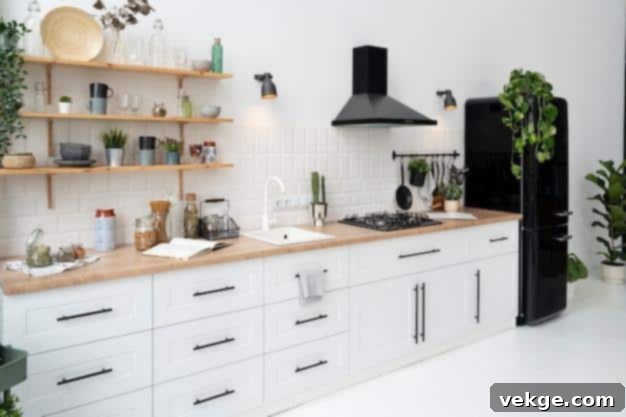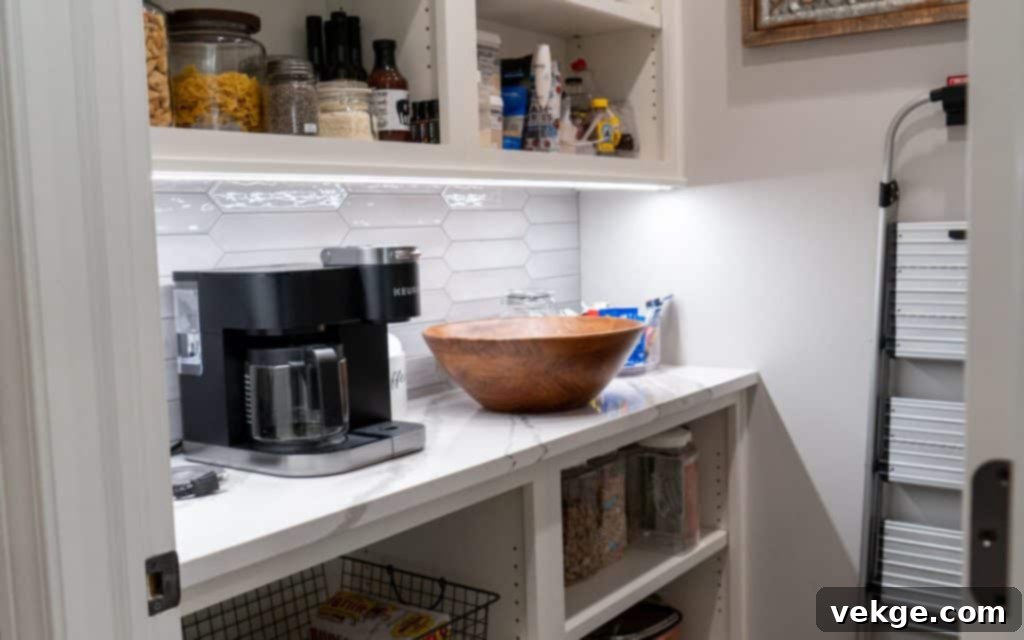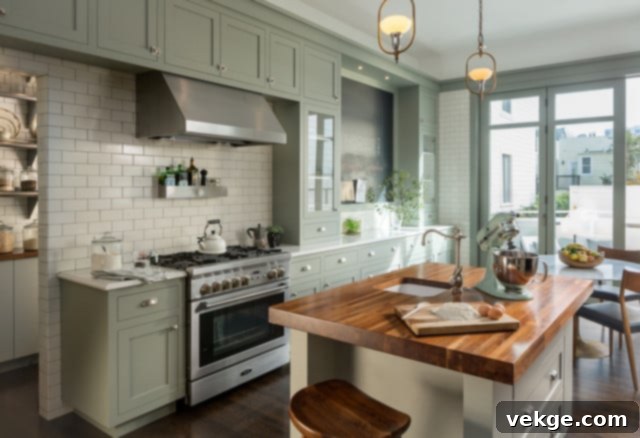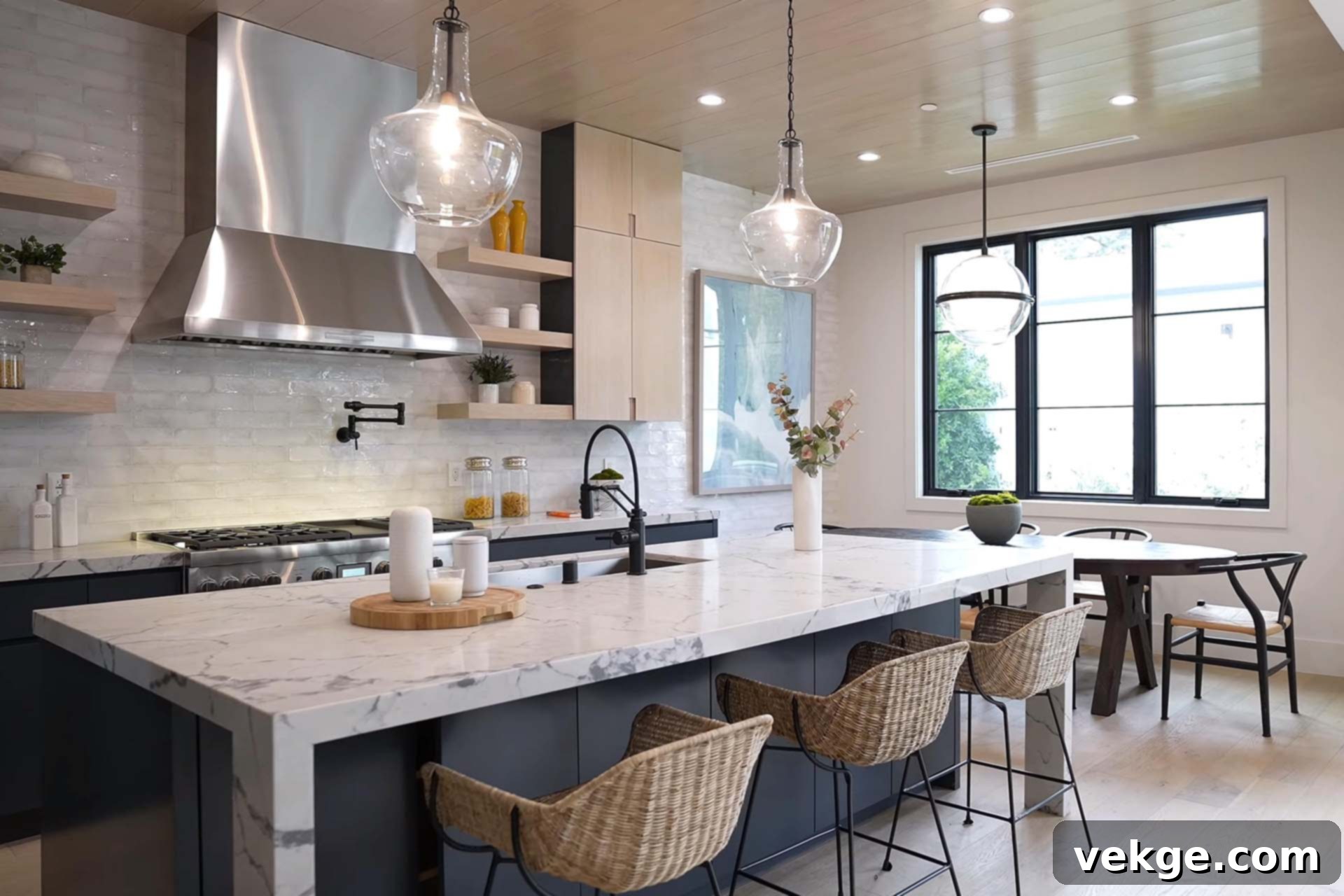Designing Your Dream Kitchen: The Ultimate Blend of Aesthetics and Functionality
Imagine your kitchen not just as a space for cooking, but as the vibrant heart of your home – a place where culinary creativity flourishes, family memories are made, and daily life unfolds with ease. This isn’t just a fantasy; it’s an achievable reality. With thoughtful planning and strategic design, you can transform your kitchen into a dream space that truly reflects your lifestyle and ignites your passion for cooking.
However, embarking on a kitchen design or renovation project is a significant undertaking. Anyone who has navigated this journey will attest to the myriad decisions and meticulous planning required. Without careful consideration, the joy of a new kitchen can quickly turn into frustration over design flaws or overlooked details. The goal is to create a space that you’ll love for years to come, avoiding the common pitfalls of a poorly planned kitchen remodel.
One of the most crucial, and often challenging, aspects of kitchen design is striking the perfect harmony between aesthetics and functionality. While a visually stunning kitchen is certainly desirable, its true value lies in how effectively it serves its purpose. A beautiful kitchen that lacks practical workflow or adequate storage will ultimately disappoint. The art lies in seamlessly blending breathtaking style with unparalleled practicality, ensuring every element not only looks good but also works hard for you. In this comprehensive guide, we’ll walk you through the essential steps to master this balance, helping you craft a kitchen that is both a feast for the eyes and a joy to use. Ready to unlock the secrets to your perfect kitchen?

Establish a Clear Vision for Your Culinary Haven
The foundation of any successful kitchen design project begins with a clear, well-defined vision. Before you even think about cabinet styles or appliance models, take a moment to deeply reflect on what you truly want and need from your kitchen. Every homeowner’s lifestyle is unique, and your kitchen should be a direct reflection of yours. Consider your daily routines: Do you host large dinner parties frequently, or is your kitchen primarily for quick family meals? Are you an avid baker requiring ample counter space and specialized storage, or do you prefer a minimalist approach? Evaluate your current cooking habits, your storage requirements, and the aesthetic style that genuinely resonates with you, whether it’s rustic farmhouse, sleek modern, classic traditional, or eclectic bohemian.
Once you’ve conceptualized the ideal look and feel of your kitchen, translating these abstract ideas into tangible inspiration is crucial. This is where a vision board becomes an invaluable tool. Gather images from interior design magazines, online platforms like Pinterest and Houzz, or even photographs of spaces that evoke the desired atmosphere. Don’t limit your vision board to just kitchen photos; include elements like paint swatches, fabric samples, natural textures, art pieces, or even words that capture the essence you’re striving for – perhaps “serene,” “vibrant,” “cozy,” or “efficient.” For instance, if natural light is a priority, symbols of sunlight or open windows can serve as a powerful reminder. This visual collage will not only consolidate your ideas but also act as a guiding compass throughout the entire design process, ensuring consistency and helping you communicate your desires effectively to designers and contractors alike. With your vision board complete, you’ll have a solid starting point for transforming your dream into a detailed kitchen design.
Optimize Your Kitchen’s Layout for Peak Efficiency
The layout of your kitchen is perhaps the single most important factor determining its functionality and overall user experience. A thoughtfully designed layout streamlines movement, minimizes effort, and enhances the joy of cooking. It dictates everything from how easily you can navigate between tasks to how well the space accommodates multiple users.
The cornerstone of an efficient kitchen layout is often the kitchen work triangle, a time-tested concept that organizes the three primary workstations: the refrigerator (food storage), the sink (prep and cleaning), and the stove (cooking). The principle is simple: these three points should form a triangle, with each leg of the triangle being between 4 and 9 feet long, and the total perimeter not exceeding 26 feet. This strategic positioning reduces unnecessary walking and makes meal preparation significantly more efficient, allowing you to seamlessly move from gathering ingredients to preparing them, and finally, to cooking. While the traditional work triangle is a fantastic guideline, modern kitchens often incorporate islands or multiple sinks, evolving this concept into “work zones” where dedicated areas for prep, cooking, and cleaning enhance functionality for contemporary needs.
Beyond the work triangle, consider the overall flow and common kitchen layouts. Popular configurations include:
- Galley Kitchen: Ideal for smaller spaces, featuring two parallel countertops.
- L-Shape Kitchen: Offers an open feel with continuous counter space, often suitable for corner spaces.
- U-Shape Kitchen: Provides maximum counter and storage space, excellent for larger families or avid cooks.
- Island Kitchen: Integrates a central island for additional prep area, seating, or storage, often combined with L-shape or U-shape layouts.
When planning your layout, also factor in traffic patterns to ensure pathways are clear and unobstructed. Think about how people will move through the kitchen – from the entrance to the dining area, or from the pantry to the refrigerator – avoiding bottlenecks. Proper planning at this stage ensures your kitchen is not only beautiful but also a highly practical and enjoyable space to work in every day.

Personalize Your Kitchen: Customization for Your Lifestyle
True kitchen perfection lies in personalization. Customization is the bridge between a generic cooking space and one that genuinely feels like home, perfectly aligning with your unique needs and aesthetic preferences. This means incorporating features and elements that not only look fantastic but also enhance your daily routine. If you’re a gourmet chef or frequently entertain, investing in a professional-grade range, a spacious refrigerator, and perhaps even a dedicated wine cooler might be a priority. For families, durable surfaces, child-friendly storage solutions, and a large dining island could be key considerations.
Smart Storage Solutions
Storage is undeniably one of the most critical elements in any functional kitchen. An abundance of culinary tools, pantry staples, and small appliances can quickly lead to clutter if not properly managed. Think beyond basic cabinets. Consider smart storage solutions like deep drawers with dividers for pots and pans, pull-out pantry shelves for easy access to groceries, corner cabinet carousels to maximize often-wasted space, or even vertical spice racks. If you have numerous utensils or specialty gadgets, opting for wide, shallow drawers with custom inserts will keep everything organized and easily accessible, transforming chaotic drawers into models of efficiency.
Cabinetry: Style Meets Substance
The choice of cabinetry profoundly impacts both the aesthetic appeal and the long-term functionality of your kitchen. It’s not merely about storing items; cabinets define the kitchen’s style, flow, and perceived spaciousness. Take the time to explore the vast array of options available: from the timeless appeal of Shaker-style cabinets and the sleek lines of modern, handleless designs, to traditional raised-panel doors that exude classic elegance. Consider the material and finish – solid wood offers durability and warmth, while laminates and lacquered surfaces provide a contemporary look and are often easier to clean. Remember that local suppliers often specialize in high-quality, modern kitchens tailored to your area’s aesthetic, so exploring regional options can be highly beneficial.
Selecting the Right Appliances
Kitchen appliances are the workhorses of your culinary space, and their selection and placement are paramount for a seamless workflow. Choose appliances that align with your cooking habits and technological preferences. Beyond the basic refrigerator, oven, and dishwasher, consider specialty appliances like steam ovens, induction cooktops, or built-in coffee makers if they enhance your lifestyle. Energy efficiency ratings are also a vital consideration, saving you money and reducing environmental impact in the long run. For a clean, minimalist aesthetic, integrated or built-in appliances that blend seamlessly with your cabinetry can create an incredibly sleek and uncluttered appearance, making your kitchen feel more spacious and sophisticated.

The Power of the Particular: Embracing Small Details
While major components like layout and cabinetry form the backbone of your kitchen, it’s often the subtle, smaller details that elevate a good design to a truly exceptional one. These finishing touches are not mere afterthoughts; they are crucial in enhancing both the aesthetics and the functionality of the space, tying everything together into a cohesive and inviting environment.
Strategic Lighting Design
Lighting is a powerful design tool that can dramatically alter the mood, functionality, and perceived size of your kitchen. Don’t rely solely on overhead fixtures. Instead, embrace a layered lighting approach:
- Task Lighting: Essential for safety and efficiency, install bright, focused lights directly over work areas like countertops, the sink, and the stove. Under-cabinet lighting is a popular and highly effective choice.
- Ambient Lighting: Provides general illumination for the entire room, often through recessed lights, ceiling fixtures, or track lighting, creating a comfortable and inviting atmosphere.
- Accent Lighting: Used to highlight architectural features, artwork, or decorative elements within the kitchen, adding depth and visual interest.
The right combination of lighting can not only make a statement and define your kitchen’s style but also improve visibility for cooking tasks and create a warm, welcoming ambiance for dining and socializing.
Choosing the Perfect Cabinet Hardware
Often underestimated, cabinet hardware – knobs and pulls – acts like the jewelry of your kitchen, capable of making a significant design impact. These small elements can instantly update the look of your cabinets, reinforce your chosen aesthetic, and enhance usability. When selecting hardware, consider the overall style of your kitchen: sleek, minimalist handles for a modern look; ornate brass knobs for a traditional feel; or rustic iron pulls for a farmhouse vibe. Beyond aesthetics, think about ergonomics. Knobs are often simpler, while pulls can be easier to grip, especially for those with limited dexterity. Consider the material, finish (e.g., matte black, brushed nickel, polished chrome), and how they complement your appliances and faucets. Investing in quality hardware ensures durability and a satisfying tactile experience every time you open a cabinet or drawer.
Beyond Hardware and Lighting
Don’t stop there. Other small details like an eye-catching backsplash, the texture and finish of your countertops (whether it’s granite, quartz, or wood), and the style of your faucet can also contribute immensely to the kitchen’s character. Even the choice of flooring, from durable tiles to warm hardwood, plays a vital role in defining the space’s overall feel and functionality. Paying attention to these seemingly minor elements ensures that every corner of your kitchen contributes to the overarching vision of beauty and practicality.

Leverage Expertise: The Value of Professional Design Advice
Embarking on a kitchen design project, whether it’s a minor refresh or a complete overhaul, can be an incredibly daunting and complex task. The sheer volume of choices, the technical considerations, and the pressure to “get it right” can easily lead to overwhelm. While many homeowners have a clear vision of their ideal kitchen, translating that vision into a practical, beautiful, and budget-friendly reality often requires a seasoned eye and specialized knowledge. This is precisely where the expertise of professional interior designers and kitchen specialists becomes invaluable.
A qualified professional brings a wealth of experience and a discerning eye for both aesthetics and functionality. They possess an in-depth understanding of current trends, materials, building codes, and innovative design solutions that you might never discover on your own. They can help you:
- Optimize Space and Flow: Designers are skilled at maximizing even challenging layouts, ensuring every inch is utilized efficiently and that the kitchen flows seamlessly.
- Navigate Choices: From selecting the perfect countertop material that withstands daily wear to choosing lighting fixtures that enhance mood and task performance, a designer can guide you through the countless options, helping you make informed decisions tailored to your lifestyle and budget.
- Avoid Costly Mistakes: Their expertise can prevent common pitfalls and costly errors, from incorrect measurements to unsuitable material choices, saving you time, money, and stress in the long run.
- Uncover Creative Solutions: Professionals often present innovative kitchen design ideas, introducing you to unique color palettes, intriguing textures, and bespoke elements that truly personalize your space and elevate it beyond the ordinary. They can help you explore styles you hadn’t considered, ensuring a design you’ll genuinely adore.
- Streamline Project Management: Perhaps one of the most significant advantages of partnering with a professional designer is the invaluable time savings. They manage the intricate details of the design process, coordinate with contractors, suppliers, and tradespeople, and keep the project on track, allowing you to focus on your daily life with minimal disruption. Their project management skills ensure a quicker, smoother, and more effective completion of your dream kitchen.
Ultimately, investing in professional advice ensures that your kitchen design is not only visually stunning but also incredibly functional, built to last, and perfectly tailored to your individual needs, turning your dream kitchen into a well-executed reality.

The Bottom Line: Your Beautifully Functional Kitchen Awaits
Creating a kitchen that perfectly balances captivating aesthetics with peak functionality is a design journey that demands thoughtful consideration and strategic planning. It’s a nuanced process, but an incredibly rewarding one. By taking the time to establish a clear vision, meticulously plan your layout, personalize every detail to suit your lifestyle, pay attention to the finer touches like lighting and hardware, and, if needed, enlist the expertise of professionals, you are well on your way to crafting a truly exceptional space.
Your kitchen should be more than just a place to cook; it should be a source of inspiration, comfort, and efficiency. By applying the comprehensive strategies outlined in this guide, you won’t just build a new kitchen – you’ll create a vibrant, functional heart for your home that is visually stunning, remarkably practical, and makes every culinary endeavor a joyous experience. Embrace the process, and soon you’ll be enjoying the dream kitchen you’ve always envisioned.
